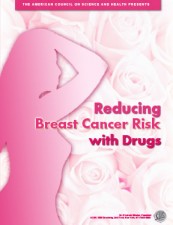
Researchers have found that some drugs indicated for breast cancer treatment aromatase inhibitors (AIs) and selective estrogen receptor modulators (SERMs) may also be effective for reducing the risk of developing breast cancer among high-risk women, with some studies showing upwards of a 50 percent decrease in cancer risk. The U.S. Food and Drug Administration (FDA) approved tamoxifen for this purpose years ago, and now raloxifene (a SERM) has also been approved. The AIs anastrozole, letrozole, and exemestane are not FDA-approved for preventive use. The AIs have only been studied in postmenopausal women, and are likely to be effective only in postmenopausal women.
SERMs block estrogen activity in certain tissues, whereas AIs block estrogen production in the adrenal glands and in fatty tissue. High-risk women who consider using these drugs for chemoprevention should take all of the potential side effects into account before starting a drug regimen, as they will need to be on the drug for years in most cases.


